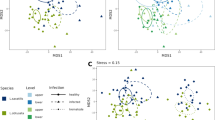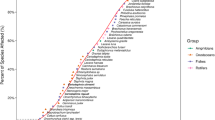Abstract
The respiratory metabolism of Asellus aquaticus L. was investigated after short-term exposure to lindane poisoning at 15 °C. After 48 h, oxygen consumption was individually recorded with a polarographic method using a Clark electrode and a Copenhagen radiometer.
The average oxygen consumption by poisoned individuals is higher than controls at concentrations lower than 8 µg·1−1 but decreases to become lower than controls at higher dosages. If the metabolism of individuals is expressed as a function of weight, we find no significant correlation between weight and metabolism of poisoned Asellus, as opposed to controls. This result can be explained by the fact that poisoning intensity decreases with body weight at a given insecticide concentration, whereas metabolism increases as a function of weight. As a consequence there is apparently a lack of correlation between weight and metabolism amongst poisoned Asellus at dosages higher than 2 µg·1−1. However, if metabolism is expressed as a metabolic ratio, a good correlation is observed between metabolism and weight of poisoned Asellus, the metabolic perturbation being significant at 4 µg·1−1 and higher concentrations.
These results prompt us to conclude that, during the initial step of intoxication, an increase of the oxygen consumption occurs under weak poisoning conditions, while higher concentrations of insecticide give rise to a decrease in metabolism.
Similar content being viewed by others
References
Basha, S. M., K. S. Prasada Rao, K. R. S. Sambasiva Rao & K. V. Ramana Rao, 1984. Respiratory potentials of fish (Tilapia mossambica) under Malathion, Carbaryl and Lindane intoxication. Bull. envir. Contam. Toxicol. 32: 570–574.
Bengeri, K. V., K. M. Shivaraj & H. S. Patil, 1984. Toxicity of Dimethyl-Parathion to Freshwater Fish Labeo rohita and oxygen uptake rate of exposed fish. Envir. Ecol. 2: 1–4.
Calabresse, A., F. P. Thurberg, M. A. Dawson & D. R. Wenzloff, 1975. Sublethal physiological stress induced by cadmium and mercury in the winter flounder, Pseudopleuronectes americanus. In J. H. Koeman & J. J. T. W. A. Strik (eds.), Sublethal effects of toxic chemicals on aquatic animals: 15–21.
Calabresse, A., F. P. Thurberg & E. Gould, 1977. Effects of cadmium, mercury and silver on marine animals. Mar. Fish. Rev. 39: 5–11.
Dalela, R. C., S. K. Bansal, A. K. Gupta & S. R. Verma, 1980. Short-term stress on the oxygen consumption of a fresh water teleost Saccobranchius Fossilis, following lethal and sublethal levels of chlordane, metasystox and sevin. Int. J. envir. Stud. 15: 229–235.
Dillon, T. M., 1983. Oxygen Consumption in the Shrimp, Palaemonetes pugio, Exposed to Fluctuating Temperature and Food Contaminated with the Diaromatic Petroleum Hydrocarbon, Dimethylnaphtalene. Estuar. coast. Shelf Sci. 16: 403–413.
Fisher, R. A. & F. Yates, 1963. Statistical tables for biological, agricultural and medical research. Longman, 146 pp.
Gerolt, P., 1983. Insecticides: Their route of entry, mechanism of transport and mode of action. Biol. Rev. 58: 233–274.
MacInnes, J. R., R. P. Thurberg, R. A. Greig & E. Gould, 1977. Long-term cadmium stress in the cunner, Tautogalabrus adspersus. Fish. Bull. 75: 199–203.
Pruz, T., 1976. Experimental and Field Studies on Ecological Energetics of Asellus aquaticus L. (Isopoda) II Respiration at Various Temperatures as an Element of Energy Budget. Ekol. Pol. 24: 607–621.
Ramade, F., 1967. Contribution à l'étude du mode d'action de certains insecticides de synthèse, plus particulièrement du Lindane et des phénomènes de résistance à ces composés chez ‘Musca domestica L.’ Ann. Inst. Nat. Agro. 5: 1–266.
Rao, D. M. R., A. P. Devi & A. S. Murty, 1981. Toxicity and Metabolism of Endosulfan and its Effect on Oxygen Consumption and Total Nitrogen Excretion of the Fish Macrognathus aculeatum. Pesticide Biochem. Physiol. 15: 282–287.
Ruber, E. & K. La France, 1983. Effects of Temephos on the respiratory rate of the salt marsh amphipod Gammarus mucronatus. Bull. envir. Contam. Toxicol. 31: 148–151.
Thurberg, F. P. & M. A. Dawson, 1974. Physiological response of cunner, Tautogalabrus adspersus, to cadmium. III Changes in osmoregulation and oxygen consumption. U.S. Dep. Commer., NOAA Tech. Rep. NMSSSRF 68: 11–13.
Zimakowska-Gnoïnska, D., 1977. Toxicological and physiological aspects of the action of herbicide, sodium salt of 2.4.D., on Asellus aquaticus L. (Isopoda). Pol. Arch. Hydrobiol. 24: 389–411.
Author information
Authors and Affiliations
Rights and permissions
About this article
Cite this article
le Bras, S. Influence du lindane sur le métabolisme respiratoire d'Asellus aquaticus L. Relation concentration — perturbation. Hydrobiologia 148, 115–122 (1987). https://doi.org/10.1007/BF00008396
Received:
Revised:
Accepted:
Issue Date:
DOI: https://doi.org/10.1007/BF00008396




